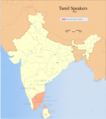Portal:Tamils
The Tamils portal
The Tamils (/ˈtæmɪlz, ˈtɑː-/ TAM-ilz, TAHM-), also known as the Tamilar, are a Dravidian ethnolinguistic group who natively speak the Tamil language and trace their ancestry mainly to the southern part of the Indian subcontinent. The Tamil language is one of the longest-surviving classical languages, with over two thousand years of written history, dating back to the Sangam period (between 300 BCE and 300 CE). Tamils constitute about 5.7% of the Indian population and form the majority in the South Indian state of Tamil Nadu and the union territory of Puducherry. They also form significant proportion of the population in Sri Lanka (15.3%), Malaysia (7%) and Singapore (5%). Tamils have migrated world-wide since the 19th century CE and a significant population exists in South Africa, Mauritius, Fiji, as well as other regions such as the Southeast Asia, Middle East, Caribbean and parts of the Western World.
Archaeological evidence from Tamil Nadu indicates a continuous history of human occupation for more than 3,800 years. In the Sangam period, Tamilakam was ruled by the Three Crowned Kings of the Cheras, Cholas and Pandyas. Smaller Velir kings and chieftains ruled certain territories and maintained relationship with the larger kingdoms. Urbanisation and mercantile activity developed along the coasts during the later Sangam period with the Tamils influencing the regional trade in the Indian Ocean region. Artifacts obtained from excavations indicate the presence of early trade relations with the Romans. The major kingdoms to rule the region later were the Pallavas (3rd–9th century CE), and the Vijayanagara Empire (14th–17th century CE). The island of Sri Lanka often saw attacks from the Indian mainland with the Cholas establishing their influence across the island and across several areas in Southeast Asia in the 10th century CE. This led to the spread of Tamil influence and contributed to the cultural Indianisation of the region. Scripts brought by Tamil traders like the Grantha and Pallava scripts, induced the development of many Southeast Asian scripts. The Jaffna Kingdom later controlled the Tamil territory in the north of the Sri Lanka from 13th to 17th century CE. European colonization began in the 17th century CE, and continued for two centuries until the middle of the 20th century. (Full article...) Selected article - The Jaffna kingdom (Tamil: யாழ்ப்பாண அரசு, Sinhala: යාපනය රාජධානිය; 1215–1619 CE), also known as Kingdom of Aryachakravarti, was a historical kingdom of what today is northern Sri Lanka. It came into existence around the town of Jaffna on the Jaffna peninsula and was traditionally thought to have been established after the invasion of Kalinga Magha from Kalinga in India. Established as a powerful force in the north, northeast and west of the island, it eventually became a tribute-paying feudatory of the Pandyan Empire in modern South India in 1258, gaining independence when the last Pandyan ruler of Madurai was defeated and expelled in 1323 by Malik Kafur, the army general of the Delhi Sultanate. For a brief period in the early to mid-14th century it was an ascendant power in the island of Sri Lanka, to which all regional kingdoms accepted subordination. However, the kingdom was overpowered by the rival Kotte kingdom around 1450 when it was invaded by Prince Sapumal under the orders of Parakramabahu VI. It gained independence from kingdom of Kotte control in 1467 after Kanakasooriya Cinkaiariyan and his two son's returned from Madurai with mercenaries to wrest the Jaffna Kingdom from Kotte's over lordship. and its subsequent rulers directed their energies towards consolidating its economic potential by maximising revenue from pearls, elephant exports and land revenue. It was less feudal than most of the other regional kingdoms on the island of Sri Lanka of the period. During this period, important local Tamil literature was produced and Hindu temples were built, including an academy for language advancement. The Sinhalese Nampota dated in its present form to the 14th or 15th century CE suggests that the whole of the Jaffna kingdom, including parts of the modern Trincomalee District, was recognised as a Tamil region by the name Demala-pattanama (Tamil city). In this work, a number of villages that are now situated in the Jaffna, Mullaitivu and Trincomalee districts are mentioned as places in Demala-pattanama. (Full article...) General imagesSelected biography -Shanmugam Kumaran Tharmalingam (Tamil: செல்வராசா பத்மநாதன்; alias Selvarasa Pathmanathan, Kumaran Pathmanathan, or simply KP; born 6 April 1955) is a former prominent member of the Liberation Tigers of Tamil Eelam (LTTE). Pathmanathan was on Interpol's most wanted list for various charges including arms smuggling and criminal conspiracy. He is also wanted by India's law enforcement agencies in connection with the assassination of former Indian Prime Minister Rajiv Gandhi in 1991 and for violation of the Terrorist Act and the Indian Explosive Act. He was arrested on 5 August 2009. Pathmanathan was released from prison on 17 October 2012, when the complaints against him by Sri Lanka were withdrawn. (Full article...) CategoriesTopicsTamil People Countrywide: India • Sri Lanka • Canada • Malaysia • Singapore • South Africa • England Related Ethnic Groups: Brahui • Gond • Kannadiga • Khonds • Kodava • Oraon • Malayali • Telugus • Tuluvas Related indigenous Groups: Badagas • Toda • Kuruba
See also: List of Tamil people, Tamil script, Tamil Script Code for Information Interchange Related portalsWikiProjectsThings to do
Associated WikimediaThe following Wikimedia Foundation sister projects provide more on this subject:
Discover Wikipedia using portals
|

























































